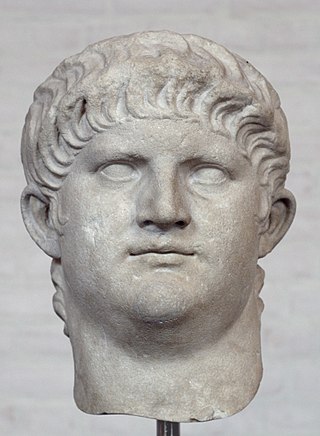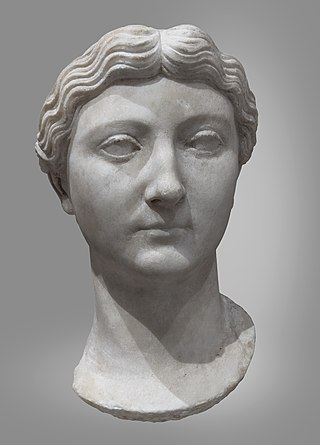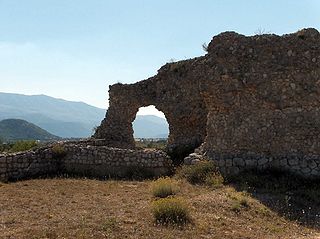
Nero Claudius Caesar Augustus Germanicus, was the fifth Roman emperor and final emperor of the Julio-Claudian dynasty, reigning from AD 54 until his death in AD 68. He was adopted by the Roman emperor Claudius at the age of 13 and succeeded him on the throne. Nero was popular with the members of his Praetorian Guard and lower-class commoners in Rome and its provinces, but he was deeply resented by the Roman aristocracy. Most contemporary sources describe him as tyrannical, self-indulgent, and debauched. After being declared a public enemy by the Roman Senate, he committed suicide at age 30.

A Roman villa was typically a farmhouse or country house built in the Roman Republic and the Roman Empire, sometimes reaching extravagant proportions.

Livia Drusilla was Roman empress from 27 BC to 14 AD as the wife of Emperor Caesar Augustus. She was known as Julia Augusta after her formal adoption into the Julian family in AD 14.

Lucius Annaeus Seneca the Younger, usually known mononymously as Seneca, was a Stoic philosopher of Ancient Rome, a statesman, dramatist, and, in one work, satirist, from the post-Augustan age of Latin literature.

The Palatine Hill, which relative to the seven hills of Rome is the centremost, is one of the most ancient parts of the city and has been called "the first nucleus of the Roman Empire." The site is now mainly a large open-air museum while the Palatine Museum houses many finds from the excavations here and from other ancient Italian sites.

Anzio is a town and comune on the coast of the Lazio region of Italy, about 51 kilometres (32 mi) south of Rome.

The Domus Aurea was a vast landscaped complex built by the Emperor Nero largely on the Oppian Hill in the heart of ancient Rome after the great fire in 64 AD had destroyed a large part of the city.

The Great Fire of Rome occurred in July AD 64. The fire began in the merchant shops around Rome's chariot stadium, Circus Maximus, on the night of 19 July. After six days, the fire was brought under control, but before the damage could be assessed, the fire reignited and burned for another three days. In the aftermath of the fire, two thirds of Rome had been destroyed.

The Esquiline Hill is one of the Seven Hills of Rome. Its southernmost cusp is the Oppius.
In ancient Roman religion, the Quinquatria or Quinquatrus was a festival sacred to the Goddess Minerva, celebrated from the 19–23 of March. The older festivals were of Etruscan origin and were to celebrate the Spring equinox, the spring rebirth rites of women. According to Varro, it was so called because it was held on the fifth (quinqu-) day after the Ides, in the same way as the Tusculans called a festival on the sixth day after the Ides Sexatrus or one on the seventh Septimatrus. Both Varro and Festus state that the Quinquatrus was celebrated for only one day, but Ovid says that it was celebrated for five days, hence the name: on the first day no blood was shed, but that on the last four there were contests of gladiators. The first day was the festival proper, and that the following four were an expansion made perhaps in the time of Caesar to gratify the people. The ancient Roman religious calendars assign only one day to the festival.

Antium was an ancient coastal town in Latium, south of Rome. An oppidum was founded by people of Latial culture, then it was the main stronghold of the Volsci people until it was conquered by the Romans.

Gnaeus Domitius Ahenobarbus was a member of the imperial Julio-Claudian dynasty of Ancient Rome. Domitius was the son of Antonia Major. He married Agrippina the Younger and became the father of the Emperor Nero.

Peltuinum was a Roman town of the Vestini, on the ancient Via Claudia Nova, 20 km east of L'Aquila, Italy, between the modern-day settlements of Prata d'Ansidonia and Castelnuovo. It was apparently the chief town of that portion of the Vestini who dwelt west of the main Apennine chain. Remains of the town walls, of an amphitheatre, of a temple and of other buildings still exist. The city was the birthplace of Gnaeus Domitius Corbulo, a Roman general from the age of Nero.

The Colossus of Nero was a 30-metre (98 ft) bronze statue that the Emperor Nero created in the vestibule of his Domus Aurea, the imperial villa complex which spanned a large area from the north side of the Palatine Hill, across the Velian ridge to the Esquiline Hill. It was modified by Nero's successors into a statue of the sun god Sol. The statue was eventually moved to a spot outside the Flavian Amphitheatre, which became known, by its proximity to the Colossus, as the Colosseum.

The Villa Poppaea is an ancient luxurious Roman seaside villa located in Torre Annunziata between Naples and Sorrento, in Southern Italy. It is also called the Villa Oplontis or Oplontis Villa A. as it was situated in the ancient Roman town of Oplontis.
After the emperor Nero committed suicide near the villa of his freedman Phaon in June of 68 AD, various Nero impostors appeared between the autumn of 69 AD and the reign of the emperor Domitian. Most scholars set the number of Nero impostors to two or three, although St. Augustine wrote of the popularity of the belief that Nero would return in his day, known as the Nero Redivivus legend. In addition to the three documented Pseudo-Neros, Suetonius refers to imperial edicts forged in the dead Nero's name that encouraged his followers and promised his imminent return to avenge himself on his enemies.
The Subiaco Dams were a group of three Roman gravity dams at Subiaco, Lazio, Italy, devised as pleasure lakes for Emperor Nero. The biggest one was the highest dam in the Roman Empire, and even in the world until its accidental destruction in 1305.

The Appian Way Regional Park is the second-largest urban park of Europe, after Losiny Ostrov National Park in Moscow. It is a protected area of around 4580 hectares, established by the Italian region of Latium. It falls primarily within the territory of Rome but parts also extend into the neighbouring towns of Ciampino and Marino.
Buphagium or Bouphagion was a town of ancient Arcadia, in the district Cynuria, situated near the sources of the river Buphagus (Βουφάγος), a tributary of the Alpheius, which formed the boundary between the territories of Heraea and Megalopolis.
















